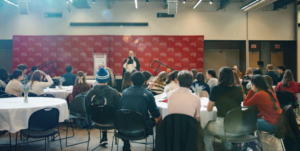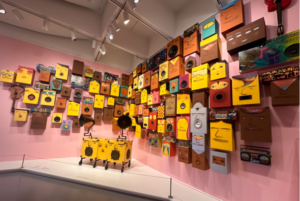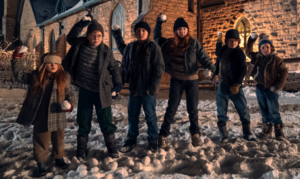Catholic University’s 2019-2020 Annual Report: Campus Life and Financial Status

Image Courtesy of The Catholic University of America
By Anna Harvey
With the recent publication of The Catholic University of America’s 2019-2020 Annual Report, the university reflects on the struggles and triumphs of the past year and discerns the best steps for the university moving forward. In addition, the report gives an analysis of CUA’s financial performance, updating the university community on expenditures made over the past year, as well as ways the university will continue to ensure longevity.
The report begins with a letter from President John Garvey, in which he appealed to the university community to apply initiatives from a platform called “Together Institute.”
“The idea is that strong communities have strong shared identities which, in theory, lead to more trust among members, even if those members have never met,” Garvey said in the letter.
Garvey also reported that the university’s Light the Way Campaign helped to draw in more funds for the university, with an initial goal of $400 million, and about $310.1 million raised in funds. In particular, with the additional donation of $20 million from Bill and Joanne Conway, the university will more speedily continue to construct the Conway School of Nursing. In addition, university alumni have given over $2 million to the university since last spring to assist with financial pressure from the coronavirus pandemic. President Garvey ended his letter on an optimistic note:
“We can’t predict the future, but the work we have done in the 2019-20 academic year gives us confidence that, together, we can manage whatever might happen,” Garvey said.
The report added that in spite of only freshmen inhabiting the campus during the fall 2020 semester, on-campus activities, events, masses, and service events continued to thrive, with over 120 students attending the Mother Teresa Day of Service.
To help regulate precautionary measures, the university enlisted student Cardinal Health Ambassadors, who encouraged other students to follow university and D.C. health guidelines to help prevent the spread of the virus. The ambassadors were intended to “show encouragement as they encounter classmates who are socially distanced effectively, while offering words of advice or education for students gathered too closely or not wearing masks.”
After the pandemic began, the report said that the university changed its annual Founders Day fundraising plan to instead direct funds to the Light the Way Crisis Response Fund. During the pandemic, nearly $2 million was raised to help with emergency student aid and tuition and campus services.
Furthermore, according to the report, more than $278,000 in emergency aid was given to students who applied for emergency assistance through the Office of the Dean of Students. In addition, the Office of Student Financial Assistance gave more than $350,000 in one-time tuition assistance grants for 62 students whose families have struggled financially from the impact of the pandemic.
“Of those students who applied for help, 87% received assistance through the Light the Way Crisis Response Fund or CARES Act funds,” said the report.
The report also detailed various cleaning procedures and physical barriers that the university took in order to prevent the spread of the virus and to clean various facilities as efficiently as possible. Portable germicidal ultraviolet (GUV) units were purchased in order to disinfect high-occupancy spaces, such as classrooms, the Kane Fitness Center, and other common spaces on campus. In some cases, the university adjusted airflow and ventilation in some buildings to prevent the spread of germs.
Education and research likewise changed throughout the year. While newly-graduated nursing students were put on the front lines of fighting the pandemic in hospitals, faculty at the university likewise attempted to find solutions within their own fields. Biology Professor Venigalla Rao helped to develop a vaccine.
“By year’s end, they had designed and successfully tested in animal models a phage T4-COVID vaccine, and began transitioning to a Phase 1 human clinical trial…. At the onset of the pandemic, the university began offering nonexclusive, royalty-free licenses to patents pertaining to Rao’s work on a bacteriophage T4 virus platform and vaccine delivery system,” said the report.
Financial Performance
A notable section of the report focuses on the university’s financial status over the past year, With the challenges presented by the coronavirus pandemic, the administration faced new hurdles in terms of negotiating a new pandemic-impacted operational environment.
Overall, however, due to the success of the Light the Way campaign, the university has continued its upward trend of net assets. At the end of the Fiscal Year 2020, the university had a positive operating margin of $18.3 million and a net asset increase of $20.6 million.
The majority of revenue for the university during the 2020 Fiscal Year came primarily from Tuition and Fees with 47.4%, as compared to tuition and fees from the 2019 Fiscal Year, with 51.2%. Over the past year, operating expenses came to $235.4 million, increasing 1.8% over the last year. In terms of expense by function 43.7% was spent on instruction, and 12.8% was spent on student services, which totals in just over 56% overall spent on either benefiting students or may be applicable to academics.
“While the pandemic did not significantly impact Fiscal Year 2020, the financial and operational implications of the pandemic on future years has become a critical discussion,” the report said.
In terms of the university’s pooled investments, however, the market value as of April 30, 2020, was $365 million, dropping by $15 million or 4.1% over the past year. Consequently, in order to promote longevity among endowments, the university allocated 4.5% of the trailing 12-quarter average of the market value to the operating budget. Currently, 56.8% of the university’s assets are invested in global public equity, followed by 13.9% invested in hedge funds.
Renovations took place in the following facilities on campus: Caldwell Hall, Flather Hall, McCort-Ward Hall, Mullen Library, Crough Center, Salve Regina Hall, and the DuFour Center. In December 2019, the university signed a lease in a building owned by Catholic Charities in Alexandria, Virginia to provide classrooms for the Metropolitan School of Professional Studies, the School of Engineering, and the Columbus School of Law. All throughout, construction has continued to take place on the new Dining Commons.
The report stated, however, that previous plans to build another residence hall had been put on hold.
“Design development for a new residence hall east of Opus Hall was suspended in April 2020,” the report said. “Focused pivoted to coronavirus response, safety, and risk mitigation measures.”
The financial performance sheet also revealed that while assets had decreased over the 2020 fiscal year in terms of cash and cash equivalents by $4,396, it increased in receivable contributions, moving from 36,307 in 2019 to 63,535 in 2020.
While the pandemic made a considerable dent in terms of market value for pooled investments, university assets remained fairly stable, allowing the university to continue to thrive as the pandemic wears on.







